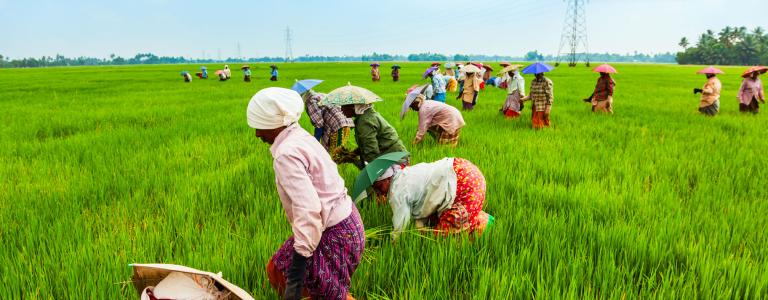The Future of Lasting Agriculture: Developments and Technologies
The Future of Lasting Agriculture: Developments and Technologies
Blog Article
Enhance Agricultural Efficiency With High-Quality Water Soluble Polymers
These polymers use a variety of benefits that can change standard farming techniques, from boosting water retention and performance to maximizing soil structure and nutrient delivery systems. By taking advantage of the power of innovative polymer solutions, farmers can potentially open new pathways towards achieving greater plant yields while minimizing ecological impacts.

Benefits of Water-Soluble Polymers
Water-soluble polymers offer a plethora of benefits in farming applications because of their enhanced water retention residential or commercial properties and capacity to boost soil structure. Agriculture. These polymers, when included to the dirt, can significantly raise water holding capability, minimizing the frequency of watering needed by crops. By forming a gel-like substance when combined with water, water-soluble polymers produce a reservoir that gradually releases moisture to plant origins, making certain a much more regular water supply throughout droughts
Additionally, these polymers aid in avoiding dirt erosion by binding dirt particles with each other, thereby improving dirt structure and security. Enhanced dirt structure allows for much better root infiltration and oygenation, advertising healthier plant development and higher crop yields. Water-soluble polymers additionally help in nutrient retention by minimizing leaching, making certain that vital nutrients stay readily available to plants for a longer period.
Improved Water Retention and Effectiveness
Enhancing agricultural water retention and efficiency through the unification of advanced polymer innovations has ended up being a paramount focus in contemporary farming methods. Water-soluble polymers play an essential duty in boosting soil framework, enhancing water seepage, and minimizing water evaporation prices. By developing a thin film on the soil surface, these polymers assist to stop water runoff and increase the dirt's water-holding capacity, making certain that plants have access to an adequate supply of water.
Moreover, the use of top quality water-soluble polymers can substantially minimize the frequency of irrigation, as they boost the soil's capability to retain dampness for longer periods. This not just saves water yet likewise minimizes the energy and labor prices linked with watering methods. Furthermore, enhanced water retention and effectiveness lead to much better nutrient uptake by plants, leading to enhanced plant returns and general agricultural performance.
Enhanced Nutrient Shipment Equipment
Given the considerable influence of top quality water-soluble polymers on improving water retention and effectiveness in agriculture, the emphasis currently shifts in the direction of optimizing nutrient delivery systems to better boost crop development and return. Improved nutrient delivery systems play an important duty in making sure that plants receive the essential nutrients in a form that is conveniently available for uptake, advertising their general wellness and performance. By including water-soluble polymers into nutrient shipment systems, the effectiveness of nutrient uptake by plants can be substantially improved.
One secret advantage of utilizing high-grade water-soluble polymers in nutrient shipment systems is their ability to regulate the launch of nutrients, guaranteeing a controlled and steady supply to plants over an extensive duration (Agriculture). This regulated launch system assists avoid nutrient leaching and overflow, thus making best use of nutrition utilization by crops and lowering ecological impact

Soil Structure Optimization Techniques
Optimizing soil structure is vital in modern farming for taking full advantage of plant yields and promoting lasting land monitoring practices. Soil structure optimization methods play a critical duty in guaranteeing that soil provides an ideal setting for plant growth. One vital method is the addition of raw material, such as compost or manure, which helps improve dirt framework by improving its water-holding capability and nutrient retention.
Additionally, exercising minimum husbandry or no-till farming can prevent soil compaction and promote the growth of a healthy soil structure. Cover chopping is an additional effective strategy that includes growing plants particularly to enhance the soil and shield, protecting against disintegration and improving soil framework.
Moreover, applying crop rotation techniques can help damage bug and condition cycles, while also improving soil framework via the differing origin frameworks of various plants. On the whole, employing these soil structure optimization methods can cause raised farming performance, decreased ecological impact, and lasting sustainability in farming practices.
Lasting Solutions for Plant Yields

To attend to the obstacles of optimizing crop yields while promoting sustainable land monitoring practices, checking out lasting solutions ends up being important in modern-day agriculture. One sustainable solution for improving plant yields is the use of precision farming techniques.
Additionally, advertising plant rotation and cover chopping can aid preserve dirt health and wellness, reduce disintegration, and enhance nutrient cycling, ultimately adding to greater returns over time. Integrated bug administration methods likewise play an essential function in sustainable their explanation plant manufacturing by decreasing the dependence on chemical pesticides and advertising all-natural parasite control approaches.
Additionally, purchasing research study and advancement for establishing drought-resistant crop ranges and climate-resilient farming practices can help minimize the influence of climate change on agriculture while making sure constant yields despite environmental challenges. By embracing these lasting solutions, farmers can attain higher plant yields while safeguarding the wellness of the land for future generations.
Final Thought
In conclusion, using high-quality water-soluble polymers in agriculture supplies various advantages such as improved water retention, enhanced nutrient distribution systems, and enhanced dirt structure. By implementing sustainable remedies for crop returns, farmers can dramatically boost agricultural performance and effectiveness. Agriculture. Water-soluble polymers supply a ecologically pleasant and cost-efficient approach to improve the general efficiency of farming methods, bring about much better results for both farmers and the environment
These look at here polymers supply a variety of benefits that can change typical farming approaches, from enhancing water retention and efficiency to optimizing dirt structure and nutrient delivery systems.In addition, these polymers aid in avoiding dirt erosion by binding dirt particles with each other, therefore boosting dirt framework and stability. By creating a slim film on the dirt surface, these polymers aid to protect against water drainage and increase the soil's water-holding ability, making sure that plants have access to a sufficient water supply.
Dirt framework optimization methods play a vital role in guaranteeing that dirt offers a suitable environment for plant development.In conclusion, the usage of high-grade water-soluble polymers in agriculture provides numerous advantages such as enhanced water retention, improved nutrient delivery systems, and maximized soil framework.
Report this page